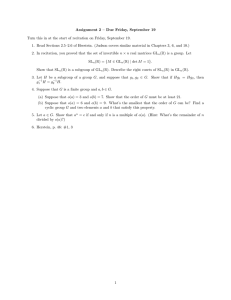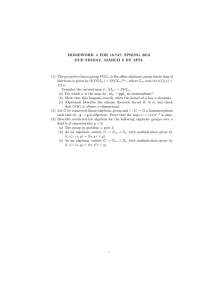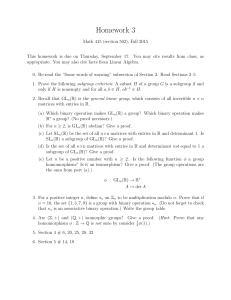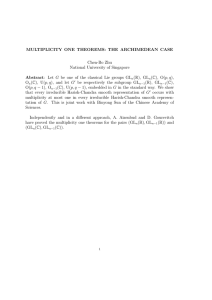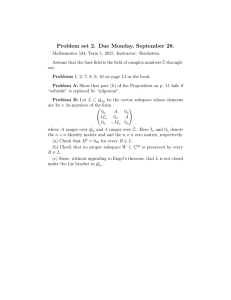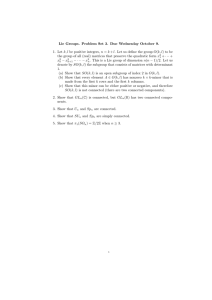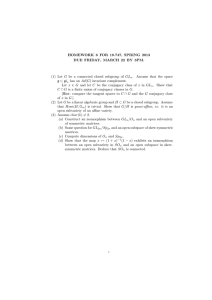Some matrix groups Minhyong Kim October 1, 2005
advertisement
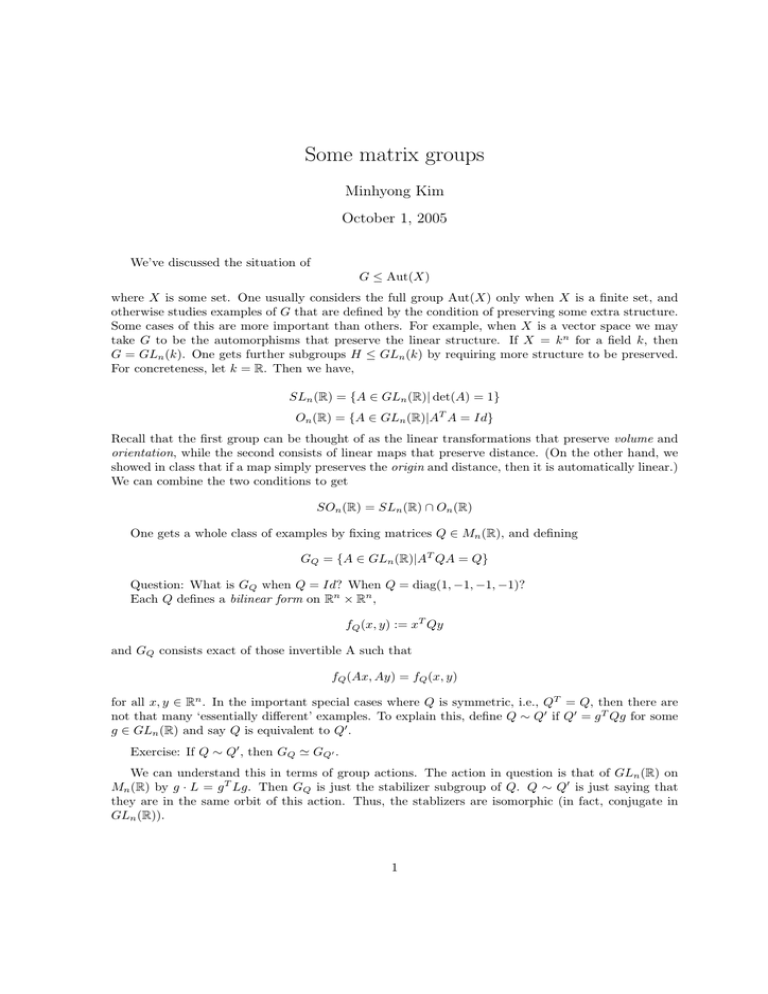
Some matrix groups
Minhyong Kim
October 1, 2005
We’ve discussed the situation of
G ≤ Aut(X)
where X is some set. One usually considers the full group Aut(X) only when X is a finite set, and
otherwise studies examples of G that are defined by the condition of preserving some extra structure.
Some cases of this are more important than others. For example, when X is a vector space we may
take G to be the automorphisms that preserve the linear structure. If X = k n for a field k, then
G = GLn (k). One gets further subgroups H ≤ GLn (k) by requiring more structure to be preserved.
For concreteness, let k = R. Then we have,
SLn (R) = {A ∈ GLn (R)| det(A) = 1}
On (R) = {A ∈ GLn (R)|AT A = Id}
Recall that the first group can be thought of as the linear transformations that preserve volume and
orientation, while the second consists of linear maps that preserve distance. (On the other hand, we
showed in class that if a map simply preserves the origin and distance, then it is automatically linear.)
We can combine the two conditions to get
SOn (R) = SLn (R) ∩ On (R)
One gets a whole class of examples by fixing matrices Q ∈ Mn (R), and defining
GQ = {A ∈ GLn (R)|AT QA = Q}
Question: What is GQ when Q = Id? When Q = diag(1, −1, −1, −1)?
Each Q defines a bilinear form on Rn × Rn ,
fQ (x, y) := xT Qy
and GQ consists exact of those invertible A such that
fQ (Ax, Ay) = fQ (x, y)
for all x, y ∈ Rn . In the important special cases where Q is symmetric, i.e., QT = Q, then there are
not that many ‘essentially different’ examples. To explain this, define Q ∼ Q0 if Q0 = g T Qg for some
g ∈ GLn (R) and say Q is equivalent to Q0 .
Exercise: If Q ∼ Q0 , then GQ ' GQ0 .
We can understand this in terms of group actions. The action in question is that of GLn (R) on
Mn (R) by g · L = g T Lg. Then GQ is just the stabilizer subgroup of Q. Q ∼ Q0 is just saying that
they are in the same orbit of this action. Thus, the stablizers are isomorphic (in fact, conjugate in
GLn (R)).
1
There is a a theorem of Sylvester that says any symmetric Q is equivalent to
diag(1, 1, . . . , 1, −1, −1, . . . , −1, 0, 0, . . . , 0)
The total number of zeroes is called the nullity of Q, while n − (nullity) is called the rank. The
difference between the number of positive signs and negative signs is called the signature of Q. Note
that the theorems says that the orbit of Q, and hence GQ is completely determined by the rank r and
signature s. (There are reasons for encoding the info in r and s, rather than, say, r and the number
of positive signs. But an explanation of this would be rather elaborate.) Thus, for a given n, we get
only finitely many groups this way. Consider for yourself the difference from the case of action by
conjugation.
If r = n, we say Q is non-degenerate (this case is more important than the degenerate). In that
case,
Q ∼ diag(1, 1, . . . , 1, −1, −1, . . . , −1)
and GQ for this diagonal matrix is sometimes written Ok,n−k (R), where k is the number of 1’s. As you
know, O1,3 (R) is called the Lorentz group, and is very important in the special theory of relativity.
Elements of the Lorentz group relate the viewpoints (that is, orthogonal coordinatization of space and
measure of time) of two observers moving uniformly with respect to each other.
Another important case is when n = 2m and we take Q to be the matrix
0
−Idm
J=
Idm
0
Then GQ is denoted Sp2m (R) and called the symplectic group. It is important in classical mechanics,
among other things. (Read just the first chapter of the nice book by Guillemin and Sternberg,
‘symplectic techniques in physics,’ for some pretty examples from optics.)
It is perfectly reasonable to consider the conjugation action and consider subgroups defined by
conditions like
AQA−1 = Q.
Of course, we are in the context of the commutator subgroup of a fixed element (If J itself is in
GLn (C).)
One important case is when Q is the J above.
Exercise: Prove that the group {A|AJA−1 = J} is isomorphic to GLm (C).
When we consider complex coefficients, there is the action by complex conjugation (don’t confuse
this sort of conjugation with conjugation by a group element) to use, so we get groups like the unitary
group:
Un (C) = {A ∈ GLn (C)|ĀT A = Id}
Exercise: Inside GL2m (R), consider the subgroups GLm (C), O2m (R), and Sp2m (R). The intersection of any two of them is Un (C). (Here, normalize the isomorphism Cm ' R2m carefully, since this
will influence the embedding of GLm (C).)
For any of these constructions, we can consider ‘special linear’ versions by imposing the determinant
one condition to get, say, SOn and SUn . One can also take the quotient by whatever scalar matrices
lie inside the group to get ‘projective’ versions, like
P GLn (R), P SLn (R), P SUn (C), . . .
Exercise: P GLn (C) ' P SLn (C). Is P GLn (R) isomorphic to P SLn (R)? Note that P SLn is in
any case always a subgroup of P GLn .
2
These constructions can be carried out over arbitrary fields (even rings, with appropriate modifications). Of course, the geometric interpretation in terms of things like distance may not be too clear,
but we have interpreted various conditions purely algebraically. Performing such operations over finite
fields Fq gives us finite groups like P SLn (Fq ).
Question: When is P SLn (Fq ) isomorphic to P GLn (Fq )? Is SLn ever isomorphic to GLn ?
The analogue of the unitary group is slightly more complicated. For this, one considers Fq2 which
is a degree two extensions of Fq . That is, Fq2 can be thought of as pairs of elements of Fq and relates
to Fq like C relates to R. Thus, there is an automorphism σ of Fq2 whose fixed field is Fq . This is
like complex conjugation. Then we can define
Un (Fq2 ) = {A ∈ GLn (Fq2 )|σ(AT )A = Id}
(Here, σ is just acting on the entries of a matrix.)
Many series of finite simple groups can be obtained via such matrix constructions (and more
complicated ones). For example, P SLn (Fq ) is simple for all n ≥ 2 except when n = 2 and q = 2, 3.
(What happens in these cases?) P SUn (Fq2 ) is simple for n ≥ 2 unless (n, q 2 ) = (2, 4), (2, 9), (3, 4).
P Sp2m (Fq ) is simple for 2m ≥ 2 unless (2m, q) = (2, 2), (2, 3), (4, 2). (In all cases, the point is that
the smallest few cases are ruled out by a process similar to what you did in the exercises.) Such simple
groups are said to be of Lie type. (By the way, you should ask yourself why we need all these S’s and
P ’s. Why not just consider GL’s?)
We have thus far met three infinite series of finite simple groups
(1) Z/p for p a prime;
(2) An , for n ≥ 5.
(3) Finite simple groups of Lie type. (Well, we haven’t really met them, but we’ve seen the easiest
examples.)
The classification theorem says that there are only 26 more finite simple groups, the so-called
sporadic simple groups. The largest of them, the subject of much mystery, wild speculation, and deep
research, is called the monster group and is denoted F1 . (Don’t confuse with the notation for finite
fields.) It has order
246 · 320 · 59 · 76 · 112 · 133 · 17 · 19 · 23 · 29 · 31 · 41 · 47 · 59 · 71
and admits a very famous homomorphism
F1 →GL196883 (C)
first constructed using ideas of string theory. In this context, you should make yourself aware as soon
as possible that homomorphisms to matrix groups are very important, even when studying groups
given in some other fashion. Such homomorphisms are called (linear) representations of the group.
One says, for example, that the monster group has a 196883-dimensional representation.
It is interesting that matrix groups can show up in situations where the structure preserved is not
a priori linear. For example, let H := {x + iy|y > 0} ⊂ C be the upper-half plane. Since we know what
an analytic function is, we can consider An(H), the group of analytic automorphisms of H. Earlier
on, we had constructed a homomorphism
P SL2 (R)→An(H)
which was actually an injection. Rather surprisingly, this map is an isomorphism. H of course does
not have any obvious natural linear structure, and the transformations are not linear ones in the usual
sense (they are often called ‘fractional linear’ transformations). Also, to get rid of any remnant of
linearity, use the Riemann mapping theorem to replace H by any strangely-shaped simply-connected
domain U in C. Then
P SL2 (R) ' An(U )
For a much simpler example, recall that the automorphism group of the three-element set is isomorphic
to SL2 (F3 ).
3
